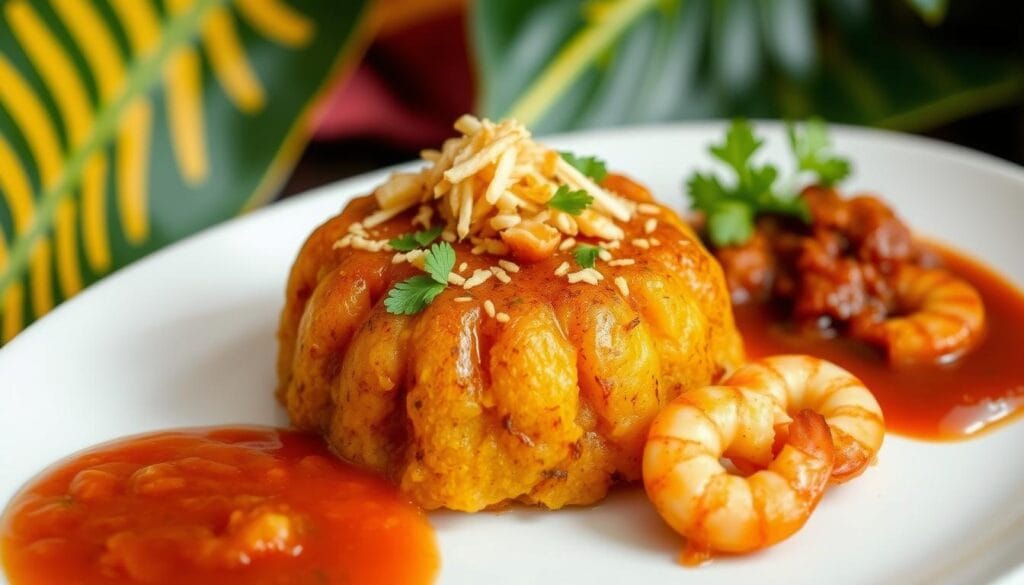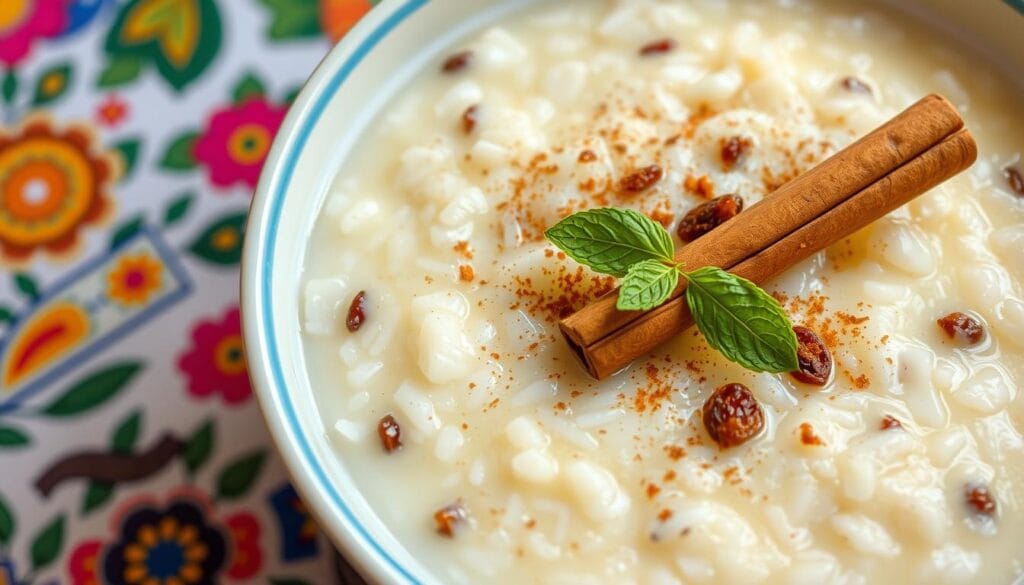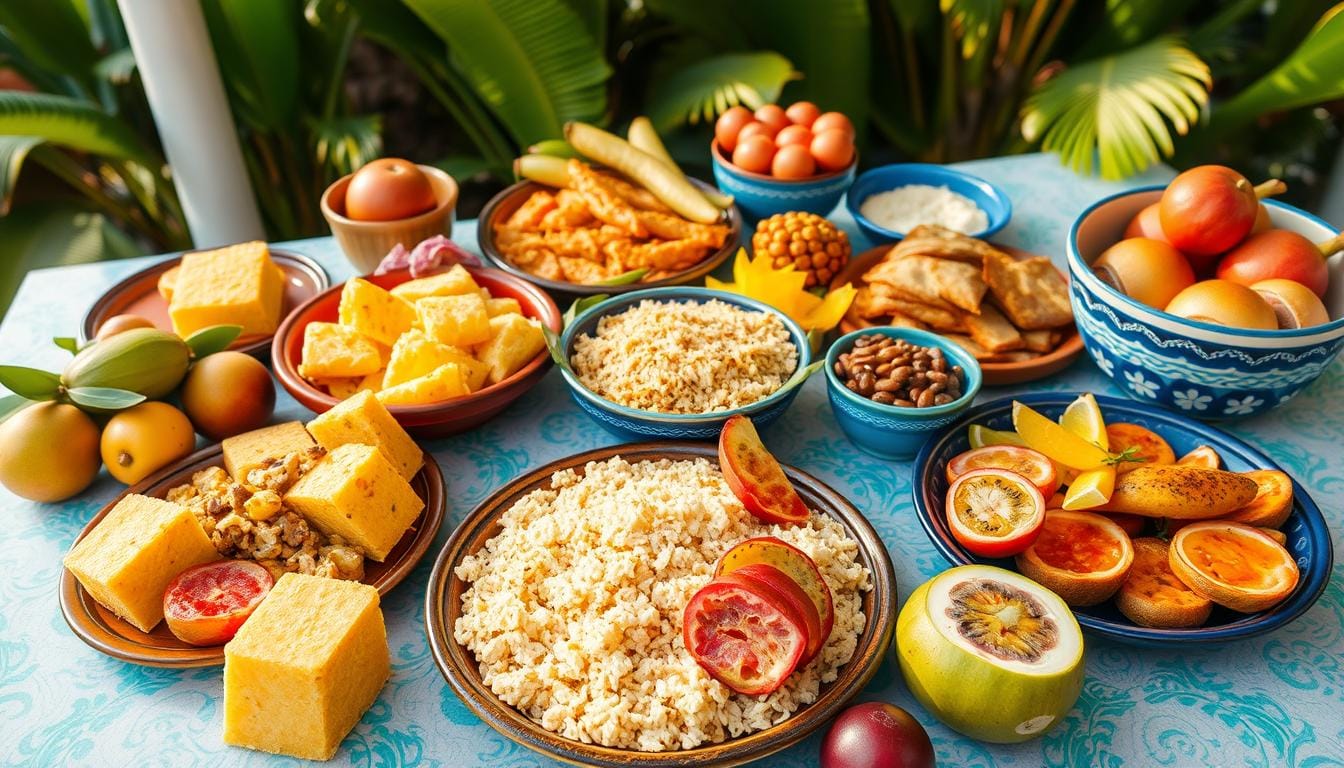Puerto Rican cuisine, or cocina criolla, is a mix of many flavors. It comes from the Taíno people, Spanish, Africans, and Americans. This article will dive into the 10 most loved Puerto Rican dishes. These dishes show the island’s rich culture and food traditions.
From slow-roasted pork, or pernil, to sweet coconut pudding, tembleque, these foods are iconic. They highlight the vibrant tastes of the Caribbean. Each dish tells a story of Puerto Rico’s history and traditions.
Table of Contents
Introduction to Puerto Rican Cuisine
Puerto Rican cuisine is a vibrant mix of traditions. It shows the island’s rich history and diverse cultures. From the Taíno people to Spanish, African, and American influences, it has grown over centuries.
Origins and Influences
The Taíno people were the first to eat in Puerto Rico. They ate cassava, sweet potatoes, maize, and tropical fruits. Then, Spanish colonization brought rice, wheat, olives, and spices.
Enslaved Africans also played a big role. They brought bananas, plantains, yams, and rice to the island.
Popular Ingredients and Flavors
Puerto Rican food is known for its bright flavors. Sofrito, a mix of onions, garlic, cilantro, and more, is key. Adobo and sazón spice blends add depth to dishes.
The island’s tropical climate offers many ingredients. You’ll find tropical fruits, root vegetables, and seafood.
Over time, Puerto Rican food has changed. It has been influenced by Italy, France, and China. Yet, its rich traditions and family meals are still at the heart of Puerto Rican culture.
Pernil (Roast Pork)
Pernil is the Puerto Rican version of Latin American-style roast pork, known as lechon. It’s a favorite dish on the island, especially during holidays. A whole suckling pig or large pork shoulder is marinated in a flavorful mojo marinade. This marinade includes minced garlic, oregano, oil, adobo seasoning, and sazón.
Preparation and Seasoning
The seasoned pork is then roasted slowly until the skin is crispy and golden. This texture is called cuerito. Preparing pernil is both an art and a labor of love. The pork shoulder needs up to 5 hours of cooking at 300°F to be tender, with an internal temperature of 205°F.
To season the pernil perfectly, the pork is rubbed with spices like adobo, garlic, sofrito, and sazón. The garlic is minced and mixed with the other seasonings. This creates a fragrant paste that is rubbed into every part of the pork.
Significance in Puerto Rican Culture
Pernil is deeply significant in Puerto Rican culture. It symbolizes family, tradition, and celebration. The smell of roasting pork fills the air during holidays. Sharing a crispy, tender pernil is a cherished ritual that brings people together.
Whether it’s the centerpiece of a Christmas feast or enjoyed all year, pernil is a beloved part of Puerto Rican culinary heritage.
“Pernil is more than just a dish – it’s a symbol of our culture, our family, and our traditions. When you smell that roasting pork, it takes you right back home.”
– Maria Hernandez, Puerto Rican home cook
Arroz con Gandules (Rice with Pigeon Peas)
Arroz con gandules is a key dish in Puerto Rican cuisine. It mixes rice with pigeon peas, known as gandules. This meal is bright and full of flavor, often enjoyed during special occasions.
The dish gets its unique orange-red color from achiote oil. This adds a subtle, earthy taste to the rice.
The base of arroz con gandules is sofrito. This mix includes cilantro, onions, peppers, and sazón for spice. Diced ham or bacon adds a savory touch. Pimento-stuffed olives bring a salty contrast to the rice and peas.
| Ingredient | Amount |
|---|---|
| Long-grain rice | 3 cups |
| Canned pigeon peas | 1 (15 oz) can |
| Low-sodium chicken broth | 2 1/2 cups |
| Sofrito | 1/4 cup |
| Olive oil | 1/3 cup |
| Diced ham steak | 1/4 cup |
| Tomato sauce | 1/3 cup |
| Sazón con achiote y culantro | 1 packet |
| Chicken bouillon cube | 1 |
| Adobo seasoning | 1 tablespoon |
| Pimento-stuffed olives | 2 tablespoons |
Making arroz con gandules is easy. The rice cooks in a mix of broth, sofrito, and spices until it’s tender. Some cooks add a banana leaf on top for extra flavor.
This dish is a big part of Puerto Rican culture. It’s often served at parties and holidays. Its warm, tasty presence shows the rich food traditions of Puerto Rico.
Mofongo (Mashed Plantains)
Mofongo is a favorite in Puerto Rican food, with roots in Africa. It comes from fufu, a dish made from mashed yams or cassava. Enslaved Africans in Puerto Rico used plantains instead, making mofongo.
To make mofongo, plantains are fried and mashed with pork skin, garlic, and spices. This creates a tasty side dish that’s a key part of Puerto Rican food. It has also inspired dishes in other Caribbean places.
African Roots and Variations
Mofongo’s story starts with West African fufu. Africans brought to Puerto Rico used plantains, creating mofongo.
Now, mofongo has many versions, thanks to different Puerto Rican families. Some include:
- The traditional Puerto Rican-style mofongo made with fried green plantains
- The old-fashioned Dominican version made with roasted plantains
- Mofongo stuffed with various meats, seafood, or vegetables
- Mofongo served in a broth, with the dish being poured over the mashed plantains
Mofongo is loved in Puerto Rico and the Caribbean. It shows the lasting impact of African cooking.

“Mofongo is a dish rarely made at home, but enjoyed by many in Puerto Rico and throughout the Caribbean.”
Asopao (Puerto Rican Stew)
Asopao is a comforting chicken soup loved in Puerto Rico. It’s a flavorful stew with chicken, ham, sofrito, tomatoes, capers, and olives. It’s a nourishing dish that brings joy to those who eat it.
The history of asopao goes back to Spanish and African influences in the Caribbean. Over time, it has changed with different ingredients and tastes. You can find asopao de pollo (chicken), asopao de mariscos (seafood), and asopao de gandules (pigeon peas). This shows the creativity of Puerto Rican cooks.
Varieties and Cultural Significance
Asopao is a favorite on cold days or rainy days. It’s also a staple at Christmas, New Year’s, and Día de Reyes. It’s often topped with smoked meats, olives, capers, avocado, and peas.
Asopao is more than just food; it’s a part of Puerto Rican traditions. It’s served at parrandas, lively Christmas caroling events. The stew is made ahead of time to feed the carolers, keeping them warm and happy.
Asopao de Pollo is one of the Top 10 Puerto Rican Foods. It’s a beloved dish that shows the island’s rich culinary heritage.
Arroz con Dulce (Sweet Rice Pudding)
Try the creamy, comforting arroz con dulce, Puerto Rico’s rice pudding. It’s vegan and gluten-free, made with coconut milk, cinnamon, and ginger. This mix creates a unique and tasty experience.
Ingredients and Preparation
To make perfect arroz con dulce, start by soaking short or medium-grain rice for 2 hours or a day. This makes the rice creamy and prevents it from becoming mushy.
After soaking, mix the rice with coconut milk, ginger, cinnamon sticks, cloves, and a bit of nutmeg. Simmer this mix for 10 minutes to blend the flavors. Then, simmer for another 15-20 minutes, stirring now and then, until it’s just right.
This pudding is sweetened with brown sugar, making it vegan and dairy-free. It becomes a rich, chilled dessert that firms up in the fridge. You can cut it into squares for serving.
While it’s best enjoyed fresh, arroz con dulce can be kept in the fridge for a few days. Adding a bit of water helps loosen it when reheating.

| Prep Time | Cook Time | Additional Time | Total Time | Yield |
|---|---|---|---|---|
| 5 minutes | 45 minutes | 5 minutes | 55 minutes | 8 servings |
The arroz con dulce recipe celebrates Puerto Rican cuisine. It combines the island’s love for coconut, spices, and rice pudding. This dish is a delightful treat that brings the Caribbean’s vibrant flavors to your table.
Tembleque (Coconut Pudding)
Tembleque is a traditional Puerto Rican dessert you must try. It’s a vegan coconut pudding with a unique, jiggly texture. The name “tembleque” comes from the Spanish word for “to tremble.”
This dessert is made with coconut milk, sugar, cornstarch, and spices. It’s a festive treat that everyone can enjoy.
Making tembleque is surprisingly easy, but the result is amazing. The secret is in the right mix of ingredients and slow cooking. You simmer coconut milk with spices like cinnamon and orange peel. Then, you add a cornstarch slurry for the wobbly texture.
Tembleque is very versatile. You can add cocoa powder for a chocolate version or orange blossom water for a floral twist. It’s also great for vegans because it’s dairy-free and egg-free.
Tembleque is a big part of Puerto Rican culture. It’s often served at New Year’s and Christmas. It’s not just a dessert; it’s a tradition that brings people together.
“Tembleque is a staple in Puerto Rican cuisine, a delightful coconut pudding that captures the essence of the tropical island’s flavors.”
Whether you love Puerto Rican food or are new to it, tembleque is a must-try. It will take you on a taste journey to the Caribbean. So, why not try this traditional treat and enjoy its unique flavors?
puerto rican foods
Puerto Rican cuisine is a vibrant mix of the island’s rich culture. It includes slow-roasted pork pernil and sweet coconut pudding tembleque. These dishes show the unique flavors and traditions of the island. They offer a delicious peek into Puerto Rico’s culinary world, whether you’re exploring or cooking at home.
Mofongo is a famous dish, made from fried green plantains, garlic, pork cracklings, and broth. It’s served with various proteins like pernil or shrimp. Another favorite is arroz con gandules, a rice dish with pigeon peas, sofrito, and achiote. It’s often enjoyed during special occasions.
Street foods like alcapurrias and tostones are also key to Puerto Rican cuisine. Alcapurrias are fritters filled with seasoned ground beef or crab. Tostones are twice-fried plantain patties, often enjoyed with garlic sauce.
Puerto Rican desserts are also worth trying. Tembleque is a coconut pudding, and arroz con dulce is a creamy rice pudding. Both are beloved desserts in Puerto Rico.
These dishes are just a few examples of puerto rican foods. They celebrate the island’s diverse cuisine, blending indigenous, Spanish, and African influences. Enjoying mofongo or tembleque gives you a taste of Puerto Rico’s rich cultural heritage.
“Puerto Rican cuisine is a celebration of the island’s vibrant history and the diverse flavors that have been passed down through generations.”
Pasteles (Puerto Rican Tamales)
Pasteles are a beloved Christmas tradition in Puerto Rico. They are made from green bananas, yautía, and other root vegetables. These are mixed into a dough, filled with seasoned pork, and wrapped in banana leaves.
Traditional Preparation and Fillings
Making pasteles is a family affair during the holidays. The pork filling is key, showing the pig’s importance in Puerto Rican culture. It’s seasoned with culantro, garlic, olive oil, capers, and garbanzo beans.
The dough, or masa, is special. It’s made from green bananas, plantains, yautía, and more. These are mixed with annatto oil, warm milk, and salt. The dough is then wrapped in banana leaves and cooked until done.
Pasteles can be frozen for months, making them perfect for holidays. They’re often served with pernil and arroz con gandules.
“The intricate process of preparing Pasteles reflects the genuine effort that goes into the holiday season.”
Pasteles truly show Puerto Rican culture and family traditions. They’re enjoyed during Christmas and Three Kings’ Day. These savory tamales are a treasured part of Puerto Rican heritage.
Coquito (Puerto Rican Eggnog)
Coquito is the heart of Puerto Rican holiday cheer, often called the island’s eggnog. It’s a creamy, festive drink loved during Christmas.
Ingredients and Holiday Traditions
Coquito mixes coconut milk, coconut cream, sweetened condensed milk, and warm spices. It also includes Puerto Rican rum. Unlike regular eggnog, Coquito doesn’t have eggs, making it unique.
Coquito’s recipe has been shared for generations. Families and vendors add their own twists. Some add chocolate or extra spices like ginger and star anise. It’s a key part of Puerto Rican Christmas and New Year’s Eve, often enjoyed with savory dishes.
Coquito is best chilled and served in small amounts. It’s rich in calories, carbs, and fat. The recipe makes about 6 cups, enough for 12 people. It can last up to 6 months in the fridge, perfect for the holiday season.
| Ingredient | Quantity |
|---|---|
| Sweetened Condensed Milk | 14 ounces |
| Evaporated Milk | 12 ounces |
| Cream of Coconut | 15 ounces |
| Puerto Rican Gold Rum | 12-13 ounces |
To make Coquito, mix the ingredients and chill for at least 4 hours. This creamy, rum-infused Coquito can be stored for up to 6 months, making it a convenient holiday treat.
“Coquito is the quintessential Puerto Rican holiday drink, a beloved part of celebrating the island’s way during the Christmas season.”
Conclusion
Puerto Rican cuisine is a vibrant mix of the island’s rich cultural heritage. It combines influences from Taíno, Spanish, African, and American traditions. The 10 iconic traditional dishes show the unique flavors and traditions passed down through generations.
Whether you’re in Puerto Rico or cooking at home, these Puerto Rican foods give a taste of the island’s culinary identity. They highlight the importance of food in Puerto Rican culture.
The variety of dishes, from arroz con gandules to coquito, mirrors the rich Puerto Rican heritage. By trying these traditional dishes, you can enjoy the vibrant flavors and connect with Puerto Rico’s cultural heritage.
Exploring Puerto Rico’s culinary scene, whether in person or in your kitchen, opens a world of authentic Caribbean food. It celebrates the island’s resilience, creativity, and spirit. Dive in, explore, and let the puerto rican cuisine take you to the heart of this captivating island nation.

